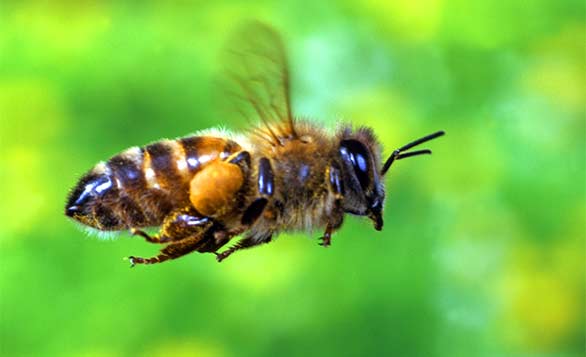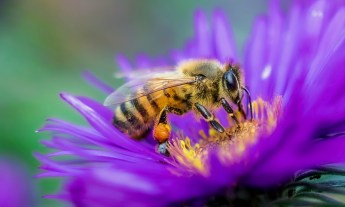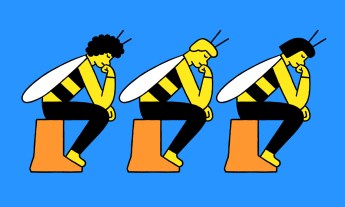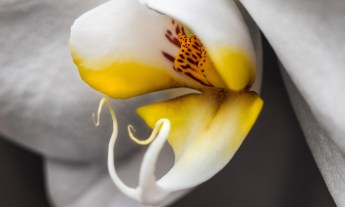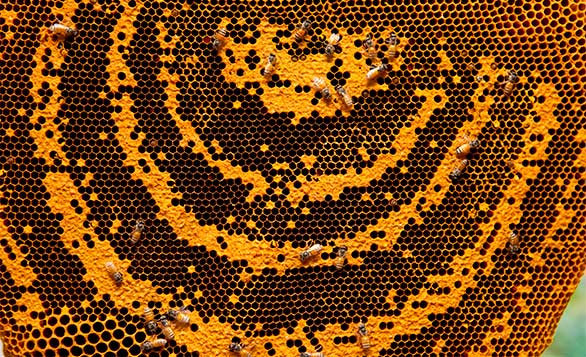
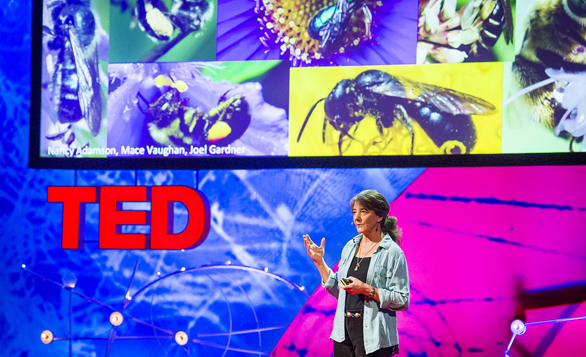
In 1945, there were 4.5 million hives of bees in the United States. Today, there are just about 2 million. It’s been a subtle decline over time, but one that has dramatically accelerated over the past seven years. And this should be extremely alarming, given that bees pollinate one-third of the world’s crops.
In today’s talk, given at TEDGlobal 2013, Marla Spivak looks at why bees are disappearing. She highlights four reasons — many related to changes in farming practices — and how they interact to tragic end. But beyond that, Spivak wonders: what do these deaths mean for us given that bees, a species our lives are deeply intertwined with, have thrived for over 50 million years?
“This small bee is holding up a large mirror,” says Spivak. “How much is it going to take to contaminate humans?”
Spivak is not the only TED speaker to express deep concern over the declining bee population. In 2008, the second year in row during which a third of bee colonies were found mysteriously dead, Dennis vanEngelsdorp made “a plea for bees.” It’s a very funny talk that looks into the serious problem of why bee colonies are susceptible to disease. Several years later, at TEDxBoston in 2012, Noah Wilson-Rich looked at the potential of urban beekeeping, providing fascinating evidence that bees appear to thrive in urban areas. (Watch all TED Talks about bees.)
The TED Blog got these three speakers on the phone for a group conversation about the state of bees.
We’re excited to get the three of you together. To start off, I’d love to hear from each of you: what is it that first sparked your interest in bees?
Noah Wilson-Rich: For me, it happened in school. I was pre-med in college, as an undergrad, I think mostly because I really didn’t know all the career options that were out there beyond teacher, doctor, lawyer, fireman and astronaut. So, I was pre-med, and I took this amazing class called “Sociobiology” that was taught by Rebecca Rosengaus, and it just changed my whole trajectory. It opened up this world of social animals and social insects, and then I ended up applying to a PhD program with Philip T.B. Starks at Tufts. That’s where I started working with honeybees. It was the beginning of a great career.
Dennis vanEngelsdorp: For me, it was also as an undergraduate. I was in a horticulture and international agriculture program — I had my own gardening company and I was sure that I was going to run my own gardening company for the rest of my life. I took a beekeeping class, and I remember just being fascinated. We went out and opened the beehives, and I got stung. And there’s a saying in the bee community: You get stung, and it’s in your blood. You know you’re a beekeeper. If I was mechanical at all — if I could use a bandsaw without fear of losing my fingers — I’d be a beekeeper. But I’m better with numbers, so I went the science route. Bees are a passion. I mean you know right away when you open a hive whether this is what you need to be doing.
Marla Spivak: I was also kind of bored and directionless as an undergrad. I picked up a book at the library on bees — and that was it. I stayed up all night reading the book, and by morning I had a career.
NWR: Which book was this?
MS: It’s called Bee’s Ways. It was written by a naturalist, I think in the 1940s. There’s just something in the book that grabbed me, and so I convinced my advisor that I needed to work for a commercial beekeeper. They sent me to New Mexico and I worked for a beekeeper for a semester.
It’s so interesting that all of these moments happened in college.
NWR: It’s time of exploration, I suppose?
DV: Yeah, a conversion moment.
Marla, in your talk, you suggest that the fascination with honeybees is because, not only are their lives intertwined with ours, but in a lot of ways, they’re like us. Could you speak to the ways that bees are like humans?
MS: I actually think it’s that humans aspire to be like bees. I mean, we live in societies, but their society is a lot more coherent. We look up to honeybees as being very efficient and well-organized, and maybe we think our own society should be more like that. I’ll let the other guys speak to that.
DV: I think it resonates with something very deep in our culture, and even goes back to our ancestors. Here’s this creature, and it sort of demands respect because there’s this aura of danger. And yet, there’s this glorious return. I always imagine that if you’ve never tasted anything sweet, tasting honey for the first time is just sort of nectar from the gods. We’ve evolved with bees, and bees have evolved with us at some level. And they’ve always inspired us. I also think it’s connected with our youth — you know, running barefoot through a meadow and getting stung in the toe. It is a rite of passage. And I think we all understand at some level that if that can’t happen anymore, that we’re diminished.
NWR: I’ve been doing some reading back on the history of humans and bees, especially with honeybees, and it’s interesting to learn about how far back our relationship with them goes. We’ve found the first cave drawings dated back to 13,000 years ago. It’s remarkable — I mean, that is many generations. We’re quite intertwined with them. I mean, we first started domesticating bees in Egypt, in boats and barges on the River Nile for agricultural pollination. Thousands of years ago, I think that was around 2400 B.C.
DV: It is really cool. There’s even a honeyguide bird in Africa. You can walk through the savannahs of Africa and this bird will land in front of you, and lead you to a beehive to collect some of the honey, and leave some of the honey for it. It does this for honey badgers too, and it does it for people. That association is long enough that the bird has evolved a behavior to help communicate where hives are.
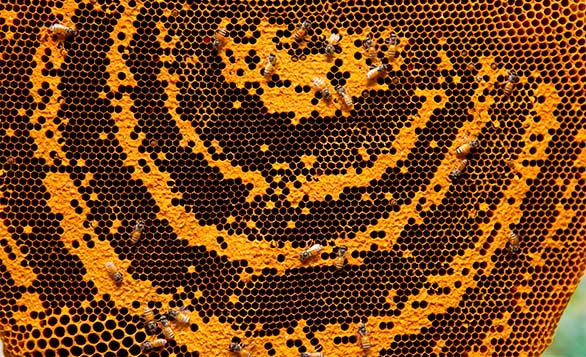
What does each of you wish the average person understood about bees?
DV: Everyone owes it to themselves to open a colony of bees once. I think some people will realize they are not beekeepers, but I think that they’ll overcome a lot of fear and they’ll be awed. Other people will fall in love. I don’t know anyone who has opened a colony of bees on a sunny beautiful day, and seen all those worker bees toiling together in harmony, and not been awed. It’s awe-inspiring. The more you do that, the more you’re connected — not only with the bees, but with the environment around you. I wish everyone that experience.
NWR: I also think this connection is something worth exploring for every human. We’ve talked a little about the past with bees, but in terms of the future: anybody who likes food likes bees. It’s important that, if you think about urban planning, you think about how to feed all of the people, and how to make the best use of space. With that comes the need for pollinators. It’s the little connections. I like apples and almonds. You’ve got bees to thank for that.
MS: I would also say — we had a big, pesticide bee-kill incident here in Minneapolis yesterday. Two of three bee colonies within a mile of each other — they’re backyard colonies in an upscale neighborhood — thousands of bees twitching dead in front of the colonies. It’s just heartbreaking. I want people to understand that we share this world with many other creatures. Bees are one of them. I would like everybody to know what they need to eat, and how far and wide honeybees will travel to find flowers as food. It’s not acceptable to contaminate their food source. And it’s not acceptable to contaminate our own food source, though bees are the ones showing it right now.
NWR: I want to add the term ‘bioindicator’ to this conversation. Die-off events that happen, they’re a message that something is off in the natural environment that we need to listen to.
DV: It’s a really good point, and I wonder whether what we need to do is have a cultural revolution. We need to change the way people think. We need to start looking at our environment really differently. The rose with the perfect leaves: that’s beautiful, but in a way that’s also disgusting, because maintaining those ornamental bushes that are perfectly shaped is hugely costly to the environment. We need to start looking at perfectly-mowed green lawns as archaic signs of a past colonial age. What we need is to have a huge bunch of variety there — we need to have native trees that support native caterpillars that support native pollinators and native birds. I think it really requires us to start looking around and becoming disgusted when we see these symbols that are supposed to signal opulence. They’re not, they’re just symbols of death.
MS: It’s really true. We overuse pesticides. We overuse antibiotics. We’re trying to get rid of all the little pesty things that bother us, but in the process we’re killing off all kinds of beneficial insects and all kinds of beneficial microbes. We’re past the tipping point on these things, and the bees are the ones that are telling us that we’ve gone too far.
DV: Everyone can do a little bit and the additive effect would be amazing. If everyone were to transform 10% of their backyard into native habitat, that would have a huge, significant impact.
NWR: Many people come to me and say, “I wish I could do something, but I can’t have bees in my apartment.” I say, “There are many things you can do without actually having to have bees on your property. Creating habitat is a huge benefit. Just planting things on your property helps.” Anybody can do that.
How do you make sure that you’re planting flowers that would be good for bees? Are there good resources for figuring out what would be good in your area?
MS: There are becoming good resources, but it’s even easier than that. Take a walk around and look at the flowers. If you see bees on them, plant those. There are a lot of native plant lists, and then there are a lot of other flowers that bees really, really like. If you stand in front of a bunch of flowers for 30 seconds, and all of a sudden bees start appearing, that’s a good flower.
DV: I do that too, Marla. When I go to the garden center in the spring, I’ll just knock the flowers and see if even those tiny little stingless bees fly out. You’re not just looking at honeybees, but you’re looking at any insects flying off the bloom because there’s a good chance that those are pollinating insects. It’s can be just this beautiful cloud. Some of these bees are so beautiful — I mean, some are like these emerald green jewels. They’re nearly as beautiful as the flowers themselves.
NWR: There’s also a very simple and fun science experiment that anybody can do at home, and based off of this website called the Great Sunflower Project. Just sit by a flower — any flower — for 10 minutes or so. Bring a pen and notepad, and write down how many bumblebees come, how many honeybees. If you don’t know what the insects are, draw them.
What other things can the average person do that would be good for bees?
NWR: You can also hang pieces of bamboo — create hollow crevices that can become an area for native bee species, or solitary bee species, to nest in.
MS: There are so many wild bees out there — I just wish people paid more attention to them. In the world, there are about 20,000 species of wild bees. In the United States, about 4,000 species. And so, like today, when there was this pesticide kill and we saw three honeybee colonies with thousands of dead, it makes me wonder: how many other bumblebees and digger bees and those beautiful emerald sweat bees that Dennis was talking about are probably dead in a field somewhere? So planting flowers is first. But second is paying very careful attention to pesticide use, and asking question before you grab the bottle. “Do I really need this? What’s in this stuff? Does this kill bees?”
NWR: At least here in Massachusetts, we’ve been having some protests about spraying pesticides out in the greater environment. Entire towns are sprayed. It’s a bit reminiscent of the DDT sprayings decades ago — it’s still happening, they’ve just changed up the chemical. That’s something that people should be aware of and perhaps question.
DV: Furthering that thought, let’s make meadows and not lawns. Buying local honey is also a really great way of supporting your local beekeepers. It’s also the most ethical sweetener, because it takes the least amount of carbon to get to your table. Becoming a beekeeper or supporting local beekeepers is something you can do as well.
NWR: There’s also a non-profit that I helped start called ClassroomHives.org that provides information for how to get observation hives inside classroom. We’ve been pretty successful in Boston, but I think if you start educating students when they’re very young — it helps.
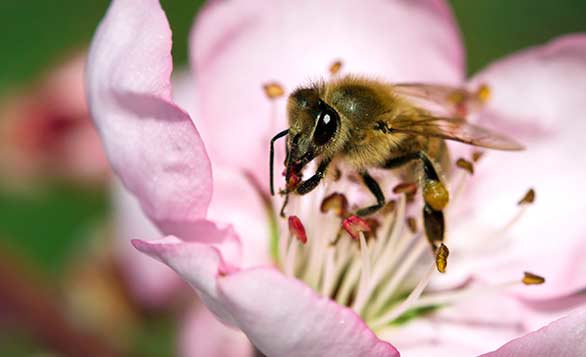 We hear a lot about colony collapse disorder in the news. Has there been any progress in understanding what’s happening?
We hear a lot about colony collapse disorder in the news. Has there been any progress in understanding what’s happening?
DV: When we first saw colony collapse disorder, we defined it with a very specific set of symptoms. I think that the term has been used more broadly to mean any colony deaths, which was never our intent. So, have we seen high levels of losses since CCD first appeared? Yes. Clearly just as high or higher. We didn’t find colony collapse disorder last winter per se, by our definition. But I think the conversation really is about: why are bees dying? I think what we all hoped, naively at the beginning, that we would find one culprit. It’s pretty clear that that’s not the case — there are lots of different culprits that interact. It’s a complicated problem. I think it’s fair to say that we’re making incremental steps in understanding that bees are being challenged by a whole bunch of things. We’ve mentioned insecticides. There’s a lot of evidence now that suggests fungicides, too, may be playing a role. The habitat loss. So we’re seeing that it’s a complex network of problems, which means the solution is also going to be complex. We are making incremental improvements in our understanding, but it’s going to be a long-term undertaking. It’s not one day we’re going to wake up and go, “Aha, we’ve solved the problem.”
What questions do you guys have for each other?
MS: Dennis, how are you going to stop ethanol subsidies? The Farm Bill now has ethanol subsidies, but it doesn’t help conserve land anymore. Corn growers are able to grow corn on marginal land, and they have subsidies and crop insurance where, even if there’s no yield on that land, they’ll get money. So they’re plowing up land that really shouldn’t be cultivated — usually land that has a lot of weeds or flowers on it that bees are using. Bees get deprived of food. It’s the same with large-scale food crops. And not just almonds, which I gave as an example in my talk — but blueberries, cranberries, any crops grown in large monocultures. They’re using herbicide to get rid of the weeds around them. Any time you use an herbicide, you’re killing off flowering plants that bees are using.
DV: It’s tricky, because these things make a lot of money, so meadows are getting plowed into habitat that’s not good for bees. People don’t get paid for coming to your lawn and sowing flowering plants. They get paid for coming in and spraying herbicides and killing plants. We’re in a capitalistic society, so how do we make it to the economic advantage to make sure that we’re leaving room for pollinators? Because clearly, the long-term benefit is there.
MS: You have to have incentives — instead of the incentive for planting corn on marginal land, make an incentive for planting prairie flowers and grasses so that you prevent soil erosion and provide habitat for pollinators. It’s got to be through incentives but, boy, I think we’re many years away from that.
DV: You can get a ticket for not mowing your lawn, but maybe we need to have incentives for people not to mow their lawn.
MS: That’d be great. I just burned off my lawn last year, and planted this prairie of flowers. I got a citation from the city of St. Paul. So I weed-whacked it down to nine inches, and I put up a big sign that says ‘Pollinator Habitat.’ I think the sign helped. This summer, a lot of the flowers came up, so it actually looks intentional.
The TED office is in New York City, where it’s become cool to keep bees. Noah, since you deal with urban beekeeping: are you invigorated by that? Is this part of the cultural change we’re looking for when it comes to bees?
NWR: Absolutely. I was just in New York City at the Intercontinental Times Square Hotel, where we went to the rooftop and got a tour of their beehive. The Times Square honey was delicious. It’s interesting — people do urban beekeeping for many different reasons, from the marketing benefit for larger companies, to just having something to look after and get a sense of agriculture in a place that’s otherwise stressful. It has definitely been a trend. Beekeeping has become so popular in New York, that there’s even talk about now putting a moratorium on new beehives. But this is actually much more than a trend. If we listen to the bees and how they’re doing, they actually prefer cities. In urban areas, they tend to make more honey. In at least the city of Boston, they also survive the winter better. So I think that even though it seems very trendy right now, it will be much more long-lasting.
MS: There’s success, but there’s high risk too. The use of pesticides in cities is not as tightly regulated as it is in agricultural landscapes. And so homeowners, park keepers, anybody in the city can use much higher concentrations of pesticides and insecticides much more frequently than they are, really, allowed by label in agricultural settings. So we really need to be really careful putting bees in cities.
NWR: One of the benefits of being a little independent bee lab is that we can fund our own research. We’re actually participating in a study, with the Harvard School of Public Health, where we’re sampling pollen from beehives all throughout Massachusetts. What my lab is doing is the greater Boston area. We don’t have the data in yet, but it’s an ongoing study to see what the pesticide levels are here compared to more rural, agricultural areas and the suburbs. Surely, it’s going to vary geographically with the pests that are trying to be controlled. It’s really a cost-benefit analysis.
To wrap things up, would each of you share a fact about bees that still boggles your mind?
NWR: Do you know how many eyes bees have? They have five eyes — two compound eyes, and then three ‘ocelli,’ or simple eyes. The compound eyes have many different components that give them some color information, and then the ocelli give a kind of light or dark contrast. I think that’s so cool.
DV: I could talk for days about the anatomy of a bee. I think that one of the things that strikes me about bees is that you often think about evolution as being this competitive thing. But bees are a testimony that sometimes evolution occurs as a dance. We have flowering plants because we have bees, and we have bees because we have flowering plants. This evolutionary dance has created beautiful blooms. I mean, these were the first advertisements — the ultraviolet markings said to bees, ‘Come here and visit me.’ The flowers produce all this pollen and nectar for the bees to bring back. Meanwhile, the bees live in these social constructs that have evolved ways of existing so that they can find the flowers efficiently. The dance that’s occurred between flowers and bees — I find it awe-inspiring.
MS: I don’t know if I can choose one! I think maybe bees’ healthcare system. They bring substances, like resins for example, into the nest that help the overall colony health. They actually go shopping for medicines with antimicrobial properties. And one other really hopeful thing I’ll end with: there’s still so much we can learn about bees.
